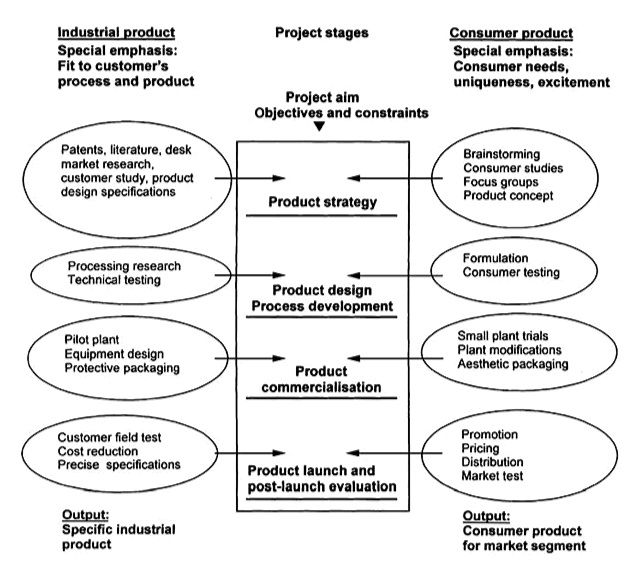FOOD
PRODUCT DEVELOPMENT
Mary Earle, Richard Earle and Allan Anderson |
| Loading
|
|
||||
|
|
Part
3
Chapter 7 Case studies: product development in the food system
in export markets
Case studies: product development in the food system
The four basic stages in the PD Process are the same for all food product development, but there are significant differences in the activities, techniques and timings for new product development in the primary production, industrial food processing, and food manufacturing industries. Primary production's product development is based on either a breeding process from cultivated varieties or capturing a new species from the wild. The development of new plants, animals and fish takes a great deal of time and depends on times of growing and harvesting. There can be a general product concept based on perceived consumer or industrial wants and needs, and on technical knowledge to identify the possible parents for the new varieties. But it takes generations to develop the suitable variants. This is described in the first Case Study on starting a new apple variety. The industrial ambience is of a farmers' cooperative fruit processing and exporting enterprise working with a national horticultural research institution. The second Case Study looks at another fresh fruit project, on mangoes. This time the emphasis is strongly on the consumer, using statistical and other quantitative techniques to build up the consumers' preference image, and then to use this consumer image and information in assessing current varieties, and moving towards improvements. This is in the framework of government/university research, a national growers' organisation and private exporters and marketers. Industrial food processing's product development is very strongly processing- based, both in the ingredient supplying and the buying companies. Food manufacture is usually directed towards providing a wide variety of products for consumers, which is continually changing. There are major differences between the activities in the PD Process for industrial and consumer products, as shown in Fig. 7.1.  Fig. 7.1 PD activities for consumer and industrial products (From Earle and Earle, Building the Future on New Products, © LFRA Ltd, 2000, by permission of Leatherhead Food RA, Leatherhead, UK). (- click to enlarge) The industrial product, a food ingredient, is usually developed in collaboration with the processors or manufacturers who are going to use the ingredient in the production of their product. These companies may provide the product design specifications or may indicate some of the qualities they need; therefore the PD Process is highly concentrated on process development and the customer does the field-testing. This is illustrated in the third Case Study in which development of an ingredient, a whey protein isolate, sophisticated both in its processing and in its market, is described. Research is carried out by an industry-wide research institute working with a university and a large farmers' cooperative dairy company and dairy marketing organisation. The fourth Case Study is the development of a consumer product, a new variety of sauces. The development was to establish a new product platform with a number of individual lines, in a large factory unit of a multinational food manufacturing company, and to sell these sauces initially locally, and then for export to major international markets. This product development was totally private enterprise. In studying these case studies, differences in activities in the four stages of the PD Process can be seen, caused by:  markets for which the products are designed; markets for which the products are designed;
 technology available and used; technology available and used;
 time taken for product development; time taken for product development;
 costs of product development; costs of product development;
 priorities set by the various parts of the food system. priorities set by the various parts of the food system.
The Case Studies cannot be taken as typical of PD Processes because each has its own special features, but they do illustrate generic features. |
|
 |